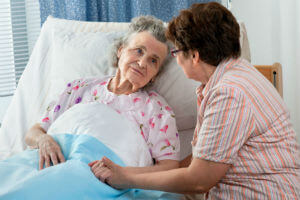
Bedsores, also known as pressure ulcers, occur on the body when a person is inactive for long periods of time. While bedsores are common among nursing home residents with mobility challenges, they can also be a warning sign that neglect is happening.
If you have a loved one who has sustained bedsores caused by neglect in a nursing home, the qualified Nursing Home Abuse lawyers in West Palm Beach can help you pursue justice. At Gordon & Partners, we will fight to hold negligent caregivers accountable for the damages they cause. Request a free consultation today to see what legal options are available to you.
Causes of Bedsores in Nursing Homes
Bedsores form when there is pressure against the skin. This causes limited blood flow to the affected area. Bedsores can occur in anyone who is immobile for long periods of time, especially to nursing home residents who are left uncared for.
Causes of bedsores include:
- Pressure: Pressure decreases blood flow to skin tissue, starving it of the oxygen and nutrients required to stay healthy. The skin is damaged and can eventually die, forming a bedsore.
- Friction: When skin constantly rubs against something, such as bedding or clothes, it becomes fragile and is more vulnerable to damage. Moist skin is especially vulnerable to bedsores caused by friction.
- Shear: When two surfaces move against each other in opposite directions, shear occurs which can cause bedsores. This can happen when the body moves over a surface such as sliding down in a bed. The bones are exerting pressure on the skin and moving as the skin stays in place, which causes the skin to be pulled in the opposite direction of movement, producing a wound.
Stages of Bedsores
Bedsore development occurs in four stages, according to severity.
- Stage one – This stage of bedsores begin as a rash. Skin pigmentation may slightly change, appearing redder or darker.
- Stage two – These types of bedsores form when the skin opens, leading to erosion. Decubitus ulcers result, causing pain and sensitivity in the affected area. The bedsore may look like a blister, cut or small crater as it begins to expand into the skin.
- Stage three – These appear like a small crater and may expose body fat.
- Stage four – This stage of bedsores goes through skin and fat layers, deep into muscle and bone. It can result in severe damage affecting the body’s deep tissue, tendons and joints.
Common Areas for Bedsores to Develop
Bedsores usually form on areas of the body where the bone is closest to the skin, such as
- Tailbone
- Buttocks
- Ankles
- Feet
- Heels
- Lower back
- Hips
Medical Complications
If left untreated, bedsores can result in severe medical complications that can be life-threatening. These complications include:
- Bone and joint infections
- Sepsis
- Gangrene
- Amputation
- Flesh-eating bacteria engaged
- Cellulitis
- Cancer of the lymph nodes or skin cells
Preventing Bedsores
While bedsores among nursing home residents are common, they are preventable. Nursing homes and caregivers should consider the following steps to prevent a bed sore before it happens:
- Reposition the body on a regular basis
- Keep the skin and body dry
- Reduce pressure on bony areas throughout the body
- Change clothing on a daily basis
- Change bedding on a regular basis
- Maintain the resident’s hygiene
- Ensure the resident receives adequate nutrition and hydration
Contact A Qualified Bedsore Attorney Now
If your loved one has suffered bedsores while under the care of a nursing home, neglect may be the cause. Get the justice your family deserves – our nursing home bedsores attorneys can help you hold negligent nursing home facilities accountable for the pain and suffering they have caused.
Schedule a free, no-obligation consultation today to review your claim and discuss your legal options. No upfront payment is required and you only pay us if we recover compensation for you.
Call (855) 722-2552 or fill out our Free Case Evaluation form now.

 855-722-2552
855-722-2552